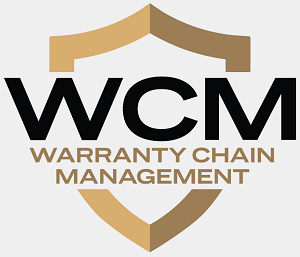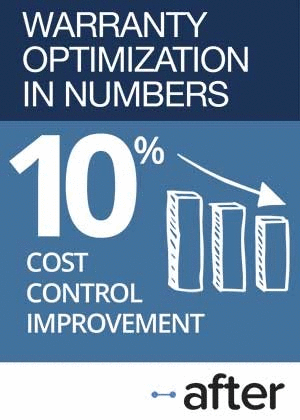Warranty Expense Reductions:
As the year comes to a close, we take a look at which of the largest warranty providers has achieved the largest expense rate reductions in the past 12 months. But in order to compare companies against each other, first we have to compare each company to itself over time.
With all the service contract market research we've been doing since the summer, we've neglected to check in on the warranty metrics published by the major manufacturers. First quarter data became available in May. Second quarter data arrived in August. And now, the third quarter data has been in since November.
So before we pack up for the holidays, we wanted to take one quick look at how many of the top manufacturers have very successfully cut their warranty expenses. For some, it's a return to normal after years of high costs. But for others, it's the latest good news after multiple years of warranty cost reduction efforts.
At this time of year, everybody's making a list and checking it twice, and Warranty Week is no exception. So what we've done is to make a list of all the companies that reduced their warranty expense rates in 2013, compared to 2012.
To find out which companies are reducing their warranty expenses the most, we started with a list of the 100 largest U.S.-based warranty providers of 2012. However, because 10 of those 100 companies report their warranty expenses only at the end of each year, and because we're comparing September 2013 to September 2012, we have no recent data for those 10. So we had to lengthen our list to include 10 substitutions, which paid somewhere between $20 and $25 million in claims last year. And then, because another two of last year's top 100 have been acquired this year (Power-One Inc. by the Swiss company ABB, and Gardner Denver Inc. in a leveraged buyout by Kohlberg Kravis Roberts & Co. LP), we added in two more substitutions.
So really, what we're analyzing are the top 112 warranty providers of 2012, which each paid out $20 million or more in claims last year, based on the warranty expense reports they filed with the U.S. Securities and Exchange Commission. However, because we don't have any recent data for 12 of those companies, we're making only 100 comparisons. When the annual data arrives in early March, we'll make comparisons for all the companies missing from this analysis.
Calculating Warranty Expense Rates
Next, we calculated the claims and accrual rates for each of those 100 companies during the third quarter of 2012 and the third quarter of 2013, by taking the amounts they reported for claims paid and accruals made, and dividing those figures by the corresponding figure for warranted products sold. The result is a pair of figures for each company that express what percentage of their product sales revenue goes towards product warranty expenses.
For many companies, the figure for warranted product revenue is significantly lower than total revenue. For instance, IBM has reported total revenue of $72 billion so far in 2013. But only $10 billion of that total is for computer hardware products that would carry a warranty. The rest is warranty-free, and therefore doesn't enter into these calculations. In other words, for these companies we're not including service revenue, mortgage revenue, interest, dividends, royalties, or sales revenue for consumables such as ink or coffee.
The next step is to compare these 100 pairs of percentages. However, we can't compare the claims and accrual rates directly. That's because the relatively high expense rates of companies such as Lexmark International Inc. and Standard Motor Products Inc. are completely normal for their industries and their business models, while the relatively low expense rates of companies such as Medtronic Inc. and Advanced Micro Devices Inc. are completely normal and expected given their industries and business models.
Comparing them directly would be like comparing apples and oranges. So what you won't see is a list of the companies with the highest or lowest claims or accrual rates. Instead, we calculated the changes in those expense rates over the past year, and then compared the changes. So what we're really doing is comparing each company to itself over time.
Over the past year, five companies cut their claims rate by half or better. Six saw their claims rate double or worse. Five cut their accrual rates in half or better, and five had to increase their accrual rates by 2x or more. We think moves like this are significant and worth reporting.
Making A List, Checking It Twice
However, rather than report both the increases and decreases, in keeping with the holiday spirit we'll report only the good in the world this week. So what follows are the top 10 decreases in the claims and accrual rates of the top 100 warranty providers, with graphical snapshots of five of them over the past decade.
In Figure 1 we're starting with the accrual rate reductions because these are the metrics that are most closely linked to product reliability and quality. At the time a product is sold, the manufacturer must estimate how much its product warranty is likely to cost over time. Then the company makes an accrual, setting aside enough money in its warranty reserve fund to pay all the predicted warranty costs over the life of the warranty. So if a company cuts its cost estimate in half (which is what's implied if the accrual rate is cut in half), it is effectively announcing that it believes its product quality and reliability has soared, or is about to soar.
Figure 1
Top 100 U.S.-based Warranty Providers:
Top Ten Accrual Rate Reductions,
Third Quarter 2013 vs. 2012
(accruals as a % of sales)

Source: Warranty Week
That's the simple explanation. It implies that companies pay close attention to their estimates of future cost, and adjust their accruals accordingly. However, sometimes, there are alternative explanations. For instance, in the third calendar quarter of 2013, RV manufacturer Thor Industries decided to make no additional net accruals. And so, its accrual rate dropped by exactly 100%, from 2.4% in September 2012 to 0% in September 2013. We doubt this means that they believe every RV they make is perfect and will need no warranty work. But as we'll see in a few paragraphs, we also doubt they know how this would look in a graph.
Second on our list is the medical device company Steris Corp. A year ago, its accrual rate was 2.2%. Now it's 0.4%, which represents a decline of more than 8/10ths. And similarly, the accrual rates of homebuilder Hovnanian Enterprises Inc., kitchen appliance maker Green Mountain Coffee Roasters Inc., and solar energy equipment maker First Solar Inc. also fell by half or more, causing them to lead our chart of the largest accrual rate reductions of the past year.
Claims Rate Reductions
Changes in the claims rate are a bit less valuable as indicators of quality improvements, for two reasons. First, there's a lag time between when a product is sold and when it needs warranty work, in contrast to an accrual that's always made at the time of sale. And second, since we're dividing the expense by sales, the resulting percentages can rise or fall significantly based on just changes in sales.
For instance, a company could one year have a 2.0% claims rate based on $50 million in claims and $2.5 billion in sales. A year later, it could once again pay out $50 million in claims, but if sales have risen to $4 billion its claims rate would have fallen to 1.25%. In other words, the claims rate's fall had nothing to do with a decrease in claims, and everything to do with an increase in sales.
That having been said, a top 10 decrease in a company's claims rate can serve to confirm the wisdom of it having made a massive reduction in its accrual rate. And sure enough, five of the companies listed in Figure 1 are repeated in Figure 2: Green Mountain, Steris, Hovnanian, First Solar, and Pentair Ltd.
Figure 2
Top 100 U.S.-based Warranty Providers:
Top Ten Claims Rate Reductions,
Third Quarter 2013 vs. 2012
(claims as a % of sales)

Source: Warranty Week
Overall, 56 of the top 100 companies reduced their claims rates in the past year, as did 49 of the top 100 with their accrual rates. And then 32 companies managed to reduce both their claims and accrual rates at the same time. Of those 32 double-cost-cutters, 11 made it onto either Figure 1 or Figure 2, or both.
At the sad end of the spectrum, 44 companies saw their claims rates rise, 51 saw their accrual rates rise, and 27 saw both rates rise. These are the companies putting coal in their warranty managers' stockings next week. For some, it's a matter of bad timing -- delayed supplier reimbursements, big payouts just before the quarter's end, etc. But for others, it's the latest data in a painfully upward trend.
And while we said we wouldn't dwell on the bad news so close to the holidays, we have to spotlight two of the naughtiest companies: over the past year, Apple Inc. saw its accrual rate rise from 1.5% to 3.2% while its claims rate nearly doubled from 1.2% to 2.4%. Could it be related to the two-year warranties the company must now provide in China, Europe, Australia and elsewhere? In addition, SanDisk Corp. saw both its claims accrual rates rise from 0.4% to 0.7% over the past year. Let's hope these are anomalies that have everything to do with bad timing, and nothing to do with rising repair costs.
Mixed Message
Careful readers will have already noted that if 32 companies saw both rates fall and 27 saw both rates rise, there must have been 41 companies that saw one rate rise and one rate fall. And indeed, that is the case. Seventeen saw their claims rate rise and their accrual rate fall, while 24 saw their accrual rate rise and their claims rate fall.
They're not the same thing. Let's look at it from a warranty manager's perspective: If my claims rate falls but I raise my accrual rate, I probably see something bad happening in the near future. Or maybe it's just a new product generation coming to market. Or maybe it's just a big boost in sales.
Conversely, if my claims rate rises but I cut my accrual rate anyway, I'm predicting better days for product quality despite the current spike in costs. It's a dangerous move -- cutting the amount you're reserving for an expense even though the size of the expense is growing. But it's explainable based on what you see happening in the near future.
And then there are the unexplainable. For instance, a year ago Thor Industries had a 2.4% accrual rate and a 2.2% claims rate. But at the end of its most recent fiscal year, its claims rate had risen to 4.0%. So what did it do? It took a net $47 million out of its warranty reserve fund -- a negative accrual. Since there's technically no such thing as a negative accrual rate, we've recast that as a 0% accrual rate combined with a downward change in estimate, but still, what's going on?
In its latest annual report, Thor Industries refers to "higher warranty costs due to increasing product complexities." We see that in the rising claims rate. But why make no net accruals? And why take so much out of the reserve fund?
The chart below tracks Thor's claims and accrual rates over the past 43 quarters. The first thing that becomes clear is that the company's baseline warranty expense rates are normally somewhere in the range of 1.5% to 3.0%. Anything outside that range is unusual. The second thing that becomes apparent is that there's a seasonality to those claims rates, rising in the cold months and falling in the warm months. This is no doubt caused by the seasonality of RV sales.
But the third thing is that once before -- back at the beginning of 2009 -- the company's claims rate also spiked and its accrual rate also plummeted. So this is the second time the company has decided to react to a sudden rise in claims with a sudden cut in accruals.
Figure 3
Thor Industries Inc.
Average Warranty Claims & Accrual Rates
(as a % of product sales, 2003-2013)

Let's move on to look at four of the five companies that made it onto both of the good lists above. The reason we're going to look at only four out of five is because one company -- Green Mountain Coffee Roasters -- seems to have cut its expense rates by changing the way it segments its revenue. The company used to segment its revenue based on a mix of geography and product types. Now it segments it into just coffee vs. coffee makers.
This makes the latest data more useful, in that it allows outsiders to compare warranty expenses to just warranted products. But it makes comparisons with past data less useful. Therefore, although the company's expense rates fell significantly in the past year, we think it has more to do with what we're counting as warranted product sales revenue and less with the actual expenses at the top of the fraction.
No Consumables
Coffee, despite its importance in the American economy, does not come with a warranty. Or more precisely, it doesn't have an express written warranty, though all foods have an implied warranty that they are edible and contain the product they are labeled to be. The same goes for printer ink, and paper filters, and rubber gloves. They're all products, but they are consumable products, not warranty-bearing hardware.
Among the remaining four companies that achieved top 10 pairings of both their claims and accrual rate reductions, the explanations are a bit more straightforward. In Figure 3, for instance, Steris is simply returning to a good position after suffering some bad years.
The medical device company ran into a significant manufacturing crisis that began back in mid-2008, which culminated when the U.S. Food and Drug Administration forced it to recall its System 1 sterilization equipment. Steris eventually discontinued that line of business, and wrote off much of the cost of doing so as a warranty expense. So what you see in Figure 4 is a welcome return to "normal" now that the crisis has passed.
Figure 4
Steris Corp.
Average Warranty Claims & Accrual Rates
(as a % of product sales, 2003-2013)

At Hovnanian, it's another case of returning to "normal" after a few bad years. In Figure 5, we can see that the homebuilder's claims and accrual rates peaked during the recessionary year of 2009, when very few new homes were sold. The four years since have seen a slow but sure recovery take hold, with the company's claims and accrual rates falling back to where they were in 2007 and before.
What you don't see on the chart is the 24% increase in home sales revenue that Hovnanian saw in the most recent quarter. That's a healthy growth rate, but some of its peers are rebounding even faster. For instance, Lennar Corp. was up by 55% in the third quarter. NVR Inc. was up 37%. And KB Home was up 29%.
Both Lennar and NVR also reduced both their warranty expense rates. KB Home, with $19.9 million in claims paid past year, was just outside the top 100 warranty providers. It did, however, manage to reduce its claims rate by almost a third, from 1.9% last year to 1.3% this year.
Figure 5
Hovnanian Enterprises Inc.
Average Warranty Claims & Accrual Rates
(as a % of product sales, 2003-2013)

It's the same story at First Solar, in a way. The third quarter of 2012 saw the solar energy equipment company's claims rate soar to nearly 2.9% because of what the company called "the manufacturing excursion occurring during the period between June 2008 to June 2009." Simply put, the excursion is now over and rates are back under one percent.
Also, while there are rumors of a sales slowdown within the solar equipment industry, it sure hasn't struck First Solar. Sales were up 51% in the third quarter. And before you assume that's what drove down expense rates, please note that the company's payout was only $11 million in this year's third quarter, down from $24 million in the same quarter last year (which was awful). So the rate decline in the chart below is a mixture of both sales growth and expense reduction (and some good timing in terms of the awful year-ago figures).
Figure 6
First Solar Inc.
Average Warranty Claims & Accrual Rates
(as a % of product sales, 2003-2013)

Finally, we wanted to include a snapshot of the warranty expense record of Pentair Ltd., known for its water pumps, woodworking equipment, and power tools. Of the four companies we've detailed, this is the only one that isn't merely returning to normal after a bad year. Instead, its warranty costs are declining because of a focused and sustained effort to reduce its warranty expenses.
In Figure 7, we note a rising trend from 2006 to 2009, and a falling trend ever since. But we also note that during each of the past 43 quarters, the claims and accrual rates have seldom been very far apart. And when they were, such as in 2008=2009 when the claims rate was ahead, or in 2009 when the accrual rate was ahead, the space between them could be explained away by the effect the recession had on sales.
In a way, perhaps that's also the explanation for all the good news in 2013. Sales are up an astonishing 109% for the first nine months of the year, but that has lots to do with the company's acquisition-heavy business strategy. And they must be buying quality companies and selling quality products, because the company's accrual rate has never been lower than it has been so far in 2013. Our advice to the stocking-stuffers? Double the bonuses these guys are taking home this holiday season.
Figure 7
Pentair Ltd.
Average Warranty Claims & Accrual Rates
(as a % of product sales, 2003-2013)

There are some honorable mentions we also want to list. Semiconductor manufacturing equipment maker Lam Research Corp. made it onto the list in Figure 2 but just missed the top 10 bracket for its accrual rate reduction. Carpet manufacturer Mohawk Industries Inc. and auto parts supplier Visteon Corp. just missed out on both top 10 lists.
Network equipment maker Ciena Corp. made it onto the Figure 1 list but just missed the claims rate list. Metering equipment maker Itron Inc. just missed out on both top 10 lists. And LKQ Corp., Brunswick Corp., and Lennar Corp. managed to cut both their expense rates appreciably, but not by enough to get them onto a top 10 list.
And so we draw a close to our eleventh year of newsletter publishing. Because of the holidays, there won't be a newsletter next week. We'll return in January with a renewed focus on both the product warranty and service contract industries. Until then, we wish all our readers a happy holiday and a healthy, safe, and prosperous new year.










